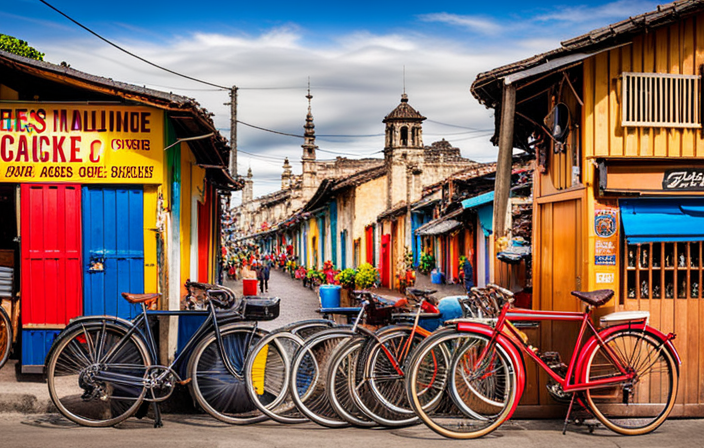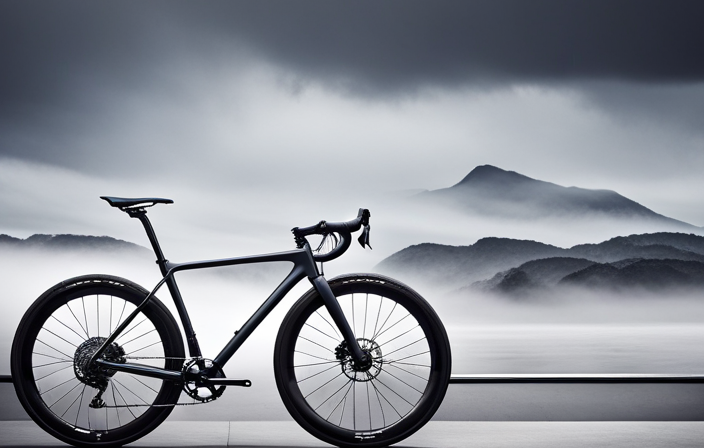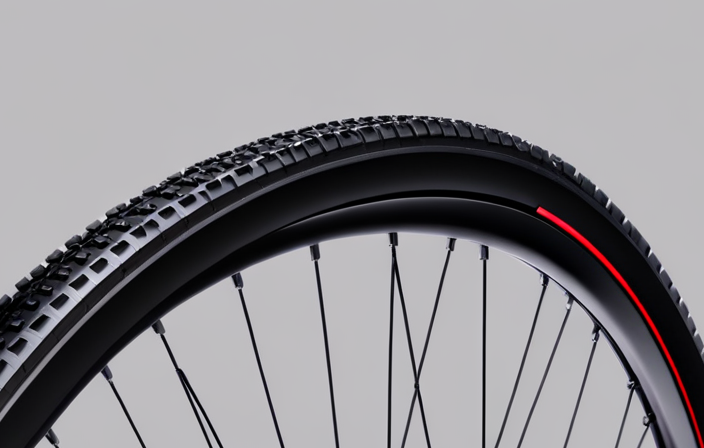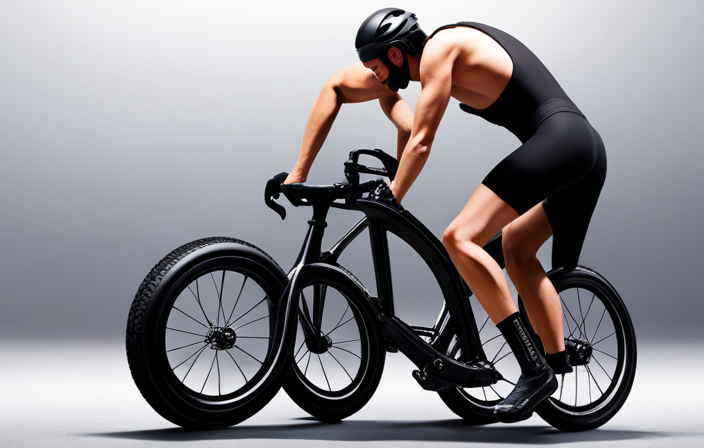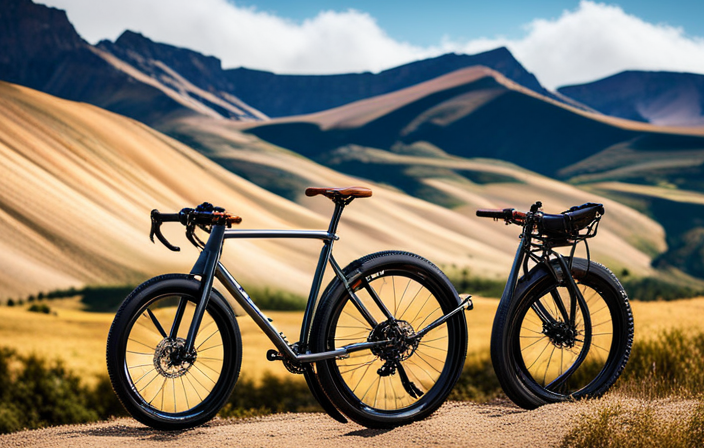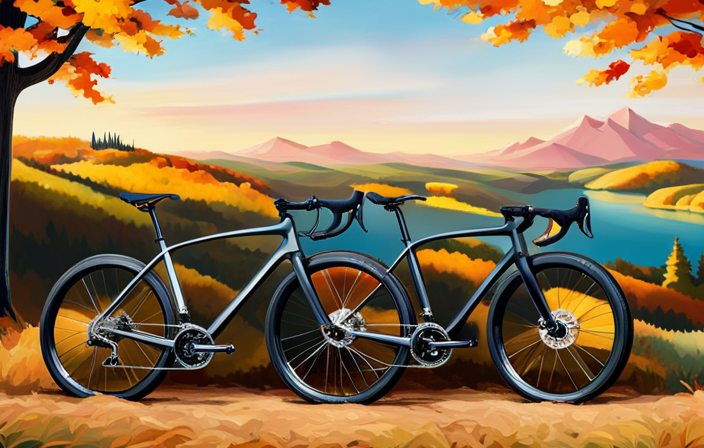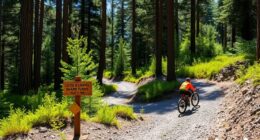Riding a gravel bike in the Philippines is akin to going on an exciting adventure, tackling challenging terrains, and discovering the beauty of the great outdoors. However, before diving into this exhilarating journey, one question lingers – how much does a gravel bike typically cost in the Philippines?
In this article, I will guide you through the world of gravel bikes, from understanding the different types to factors that affect their price. Stay tuned as we delve into finding the best deal and investing wisely in your very own gravel bike journey.
Key Takeaways
- The price of gravel bikes in the Philippines can vary depending on factors such as frame material, components, and wheelset options.
- Carbon fiber frames tend to be more expensive than other materials, while higher-end components from reputable brands can increase the cost.
- Carbon wheels are lighter and more aerodynamic but pricier than alloy wheels.
- Researching different brands and models, comparing prices, and looking for sales and discounts can help find the best deal on a gravel bike in the Philippines.
Overview of Gravel Bikes
Gravel bikes, also known as adventure bikes, are becoming increasingly popular in the Philippines. These versatile bicycles are designed for off-road cycling adventures and offer a range of features that make them perfect for tackling various terrains.
Gravel bikes typically have wider tires with knobby treads, providing better traction on gravel, dirt, and even pavement. They also feature a more relaxed geometry compared to road bikes, offering a comfortable riding position for long-distance journeys.
One of the main benefits of gravel biking is the ability to explore new routes and go off the beaten path. With a gravel bike, you can venture into remote areas and discover hidden trails that would be inaccessible on a standard road bike. This opens up a whole new world of adventure opportunities for cyclists in the Philippines.
Additionally, gravel biking provides an excellent workout as it engages different muscle groups while navigating challenging terrain. It offers an exciting mix of endurance training and technical skills development. Moreover, gravel bikes often come equipped with mounts for racks and panniers, allowing riders to carry essential gear and supplies for longer rides or bikepacking trips.
Now let’s delve into the different types of gravel bikes available in the market today without wasting any time.
Types of Gravel Bikes
When you’re looking for a new ride, there are various types of bikes designed specifically for rough terrains and off-road adventures. One popular choice among cyclists is the gravel bike. Gravel bikes are versatile machines that excel on both paved roads and unpaved trails, making them perfect for exploring different terrains.
When choosing a gravel bike, it’s important to consider factors such as sizing and features. Gravel bike sizing is crucial to ensure a comfortable and efficient ride. These bikes typically come in a wide range of sizes to accommodate riders of different heights and body proportions. It’s essential to choose the right size to avoid discomfort or potential injuries while riding.
In terms of features, gravel bikes usually have wider tires compared to road bikes, providing better traction on loose surfaces. They also come with disc brakes for reliable stopping power in all conditions. Additionally, gravel bikes often have more relaxed geometry than road bikes, offering a more upright riding position for increased stability and comfort during long rides.
Considering these factors affecting the price of gravel bikes will help you make an informed decision when purchasing your next adventure companion.
Factors Affecting the Price
To get the best value for your money, consider the factors that influence the price of a gravel bike.
The price range of gravel bikes can vary significantly depending on several key factors:
-
Frame Material: Gravel bikes are available in different frame materials, such as aluminum, steel, carbon fiber, and titanium. Each material has its own advantages and cost implications. Carbon fiber frames are lightweight but tend to be more expensive.
-
Components: The components used in a gravel bike greatly affect its price. Higher-end components from reputable brands like Shimano or SRAM will drive up the cost. These components directly impact performance and durability.
-
Wheelset: Gravel bikes come with various wheel options, including alloy and carbon wheels. Carbon wheels are lighter and more aerodynamic but also pricier than alloy ones.
Factors like brand reputation, technology advancements, and additional features like suspension or electronic shifting systems can also contribute to the overall price range of a gravel bike.
Considering these factors will help you make an informed decision while searching for your ideal gravel bike within your budget.
Moving forward into the discussion about entry-level gravel bikes…
Entry-Level Gravel Bikes
If you’re looking to start exploring off-road trails, entry-level gravel bikes are a great option for beginners. These bikes are designed to handle various terrains while providing a comfortable and enjoyable riding experience.
When it comes to features, entry-level gravel bikes usually have lightweight aluminum frames that offer durability without breaking the bank. They often come with wider tires, typically around 35-40mm, which provide stability and grip on loose surfaces.
Popular gravel bike brands that offer entry-level options include Giant, Specialized, Trek, and Cannondale. These brands have established themselves in the cycling industry and are known for producing high-quality bikes at different price points. Entry-level gravel bikes from these brands often come equipped with reliable drivetrain components such as Shimano Claris or Sora groupsets.
Transitioning into the subsequent section about mid-range gravel bikes, if you’re looking for more advanced features and performance upgrades beyond what entry-level models offer, mid-range gravel bikes might be the next step.
Mid-Range Gravel Bikes
Transitioning into the mid-range gravel bike category, you’ll find more advanced features and performance upgrades to enhance your riding experience.
When it comes to mid-range gravel bike brands in the Philippines, there are several options that offer great value for money. One popular brand is Giant, known for their durable frames and reliable components. Their mid-range gravel bikes come equipped with hydraulic disc brakes for improved stopping power, as well as wider tires for better traction on different terrains.
Another reputable brand in this category is Specialized. Their mid-range gravel bikes feature lightweight frames made from high-quality materials such as carbon fiber or aluminum alloy. These bikes also often come with suspension forks to absorb shocks and vibrations during off-road rides.
When it comes to popular gravel bike routes in the Philippines, there are a few standout options. The Sierra Madre Mountain Range offers challenging trails with breathtaking views of lush forests and cascading waterfalls. Another popular route is the La Mesa Nature Reserve, which provides a mix of paved roads and dirt paths surrounded by natural beauty.
As you explore these mid-range options and discover the joy of gravel biking, you may find yourself yearning for even more advanced features and performance capabilities. In the next section about high-end gravel bikes, we will delve into top-tier models that cater to serious enthusiasts seeking the ultimate riding experience without compromising on quality or technology.
High-End Gravel Bikes
Moving on from mid-range gravel bikes, let’s delve into the realm of high-end gravel bike options available in the Philippines. When it comes to these top-tier models, there are several renowned gravel bike brands that offer exceptional quality and performance.
One notable brand is Specialized, known for their innovative designs and cutting-edge technology. Their high-end gravel bikes boast features like lightweight carbon frames, advanced suspension systems, and precise shifting mechanisms.
Another popular option is Trek, which offers a range of high-end gravel bikes designed for off-road adventures with rugged durability and unmatched versatility.
In addition to these well-known brands, there are also local bike manufacturers in the Philippines that produce top-of-the-line gravel bikes. These homegrown options provide riders with the opportunity to support local craftsmanship while enjoying premium quality.
Whether you choose an internationally recognized brand or opt for a locally made masterpiece, investing in a high-end gravel bike ensures an unparalleled riding experience. With their superior components and meticulous attention to detail, these bikes guarantee optimal performance on any terrain.
Now that we’ve explored the world of high-end gravel bikes in the Philippines, let’s take a closer look at the essential components that make up these remarkable machines – starting with gravel bike frames and components.
Gravel Bike Frames and Components
When it comes to high-end gravel bikes, the frames and components are crucial for ensuring optimal performance and durability. Gravel bike customization has become increasingly popular among cycling enthusiasts in the Philippines. There are several popular gravel bike brands that offer a wide range of frame options and components to suit different riding styles and preferences.
One important aspect of gravel bike frames is their material composition. Carbon fiber frames are known for their lightweight yet strong construction, providing excellent power transfer and vibration damping. Aluminum frames, on the other hand, offer affordability without compromising durability. Titanium frames strike a balance between weight, strength, and comfort.
In terms of components, high-end gravel bikes often feature top-of-the-line drivetrain systems such as Shimano GRX or SRAM Force AXS. These provide smooth shifting performance even on rough terrains. Hydraulic disc brakes ensure reliable stopping power in all weather conditions.
To further illustrate the variety of options available when customizing a gravel bike, here is a table showcasing some popular gravel bike brands along with their notable frame materials:
| Brand | Frame Material |
|---|---|
| Specialized | Carbon Fiber |
| Trek | Aluminum |
| Canyon | Carbon Fiber |
| Santa Cruz | Titanium |
When it comes to purchasing high-quality gravel bikes in the Philippines, there are various reputable dealers and online platforms that offer these sought-after models. It’s important to do thorough research and compare prices before making a decision on where to buy your ideal gravel bike.
Now let’s move onto exploring where you can buy these exceptional gravel bikes in the Philippines without delay.
Where to Buy Gravel Bikes in the Philippines
When it comes to purchasing a gravel bike in the Philippines, it’s important to know where to find reliable options. Fortunately, there are several places that offer a wide selection of gravel bikes to suit all preferences and budgets.
One popular option is local bike shops, which often carry a variety of gravel bike brands such as Specialized, Giant, and Trek. These shops usually have knowledgeable staff who can assist you in finding the right bike for your needs. Additionally, they may also offer services like bike fittings and test rides to ensure that you make an informed decision.
Another great place to look for gravel bikes is online marketplaces. Websites like Lazada and Shopee have become increasingly popular platforms for buying bikes in the Philippines. Here, you can find a range of options from both local and international sellers at competitive prices.
In addition to these traditional avenues, keep an eye out for gravel bike events happening around the country. These events often attract vendors who showcase their latest models and offer exclusive deals. Attending these events not only gives you the opportunity to see different bikes up close but also allows you to connect with fellow enthusiasts and learn more about this exciting sport.
Now that we know where to buy gravel bikes in the Philippines let’s delve into the average price range for these versatile machines.
Average Price Range for Gravel Bikes
One popular option for purchasing a gravel bike in the Philippines is through local bike shops. They offer a wide selection of brands and knowledgeable staff to assist customers in finding the right fit.
When it comes to the average price range for gravel bikes, it can vary depending on the brand and specifications. However, on average, you can expect to pay around PHP 30,000 to PHP 80,000 for a quality gravel bike in the Philippines.
If you’re looking for the best brands available, there are several options to choose from. Some of the top brands known for their high-quality gravel bikes include Specialized, Giant, Trek, Cannondale, and Salsa. These brands offer durable frames, reliable components, and excellent performance on various terrains.
When considering your options at local bike shops or online sellers in the Philippines, keep an eye out for discounts and promotions. Many stores often have sales or special offers that can help you get a better deal on your purchase. By taking advantage of these opportunities, you may be able to save some money while still getting a top-notch gravel bike.
In terms of discounts and promotions available in the market today… [transition into subsequent section]
Discounts and Promotions
There are various discounts and promotions available in the market today for purchasing a quality gravel bike. As an informed consumer, it is crucial to be aware of these deals to make the most out of your budget. From time to time, bike shops offer discounts on specific models or brands, giving you the opportunity to save money while still getting a top-notch gravel bike. Additionally, some retailers may have ongoing promotions where you can receive free accessories or upgrades when you purchase a gravel bike.
To further illustrate the potential savings you can enjoy, here is a table showcasing some hypothetical examples of discounts and promotions:
| Model | Original Price (PHP) | Discounted Price (PHP) |
|---|---|---|
| Brand A Gravel Bike | 50,000 | 45,000 |
| Brand B Gravel Bike | 60,000 | 55,000 |
| Brand C Gravel Bike | 70,000 | 65,000 |
| Brand D Gravel Bike | 80,000 | 75,000 |
These numbers are just examples and may not reflect current market prices. However, they give you an idea of the potential price range and savings that could be available through discounts and promotions.
Now let’s transition into discussing another option for purchasing a gravel bike – second-hand options.
Second-Hand Gravel Bikes
Consider exploring the option of purchasing a used gravel bike to potentially find a more affordable and budget-friendly option. When buying used, there is a chance to save some money compared to buying brand new.
Gravel bikes have become increasingly popular in the Philippines, leading to a growing market for second-hand options. Many cyclists often upgrade their bikes or simply decide to sell them, creating opportunities for buyers looking for good deals.
One advantage of buying used is that you can find higher-end models at lower prices. Some sellers may be willing to negotiate on the price, allowing you to get an even better deal. Additionally, if you decide to sell your bike in the future, well-maintained gravel bikes tend to hold their resale value quite well.
However, it’s important to be cautious when purchasing a used bike. Inspect the condition of the frame, wheels, gears, and brakes thoroughly before making a decision. Consider bringing along someone with experience or knowledge about bikes if you’re unsure.
In conclusion, buying a used gravel bike can be an excellent way to find an affordable option without compromising on quality. Once you’ve found your perfect ride, it’s time to consider what accessories and gear will enhance your gravel biking experience without breaking the bank.
Accessories and Gear for Gravel Biking
When it comes to gravel biking, don’t forget to invest in essential accessories and gear that will enhance your riding experience. Having the right equipment not only improves comfort but also ensures safety on the trails. Here are some must-have accessories and gear for gravel biking:
| Accessories | Gear |
|---|---|
| – Helmet | – Gravel bike |
| – Gloves | – Flat pedals |
| – Cycling shorts | – Comfortable saddle |
| – Sunglasses | – Hydration pack |
| – Bike lights | – Multi-tool |
Wearing a helmet is crucial for protecting your head in case of falls or accidents. Gloves offer a better grip while cycling, reduce hand fatigue, and provide some cushioning. Cycling shorts with padding can make long rides more comfortable by reducing chafing and pressure points.
Sunglasses shield your eyes from dirt, dust, and harmful UV rays. Bike lights are essential for visibility during low light conditions or night rides.
Investing in a good gravel bike with flat pedals allows you to easily navigate various terrains. A comfortable saddle ensures that you can ride for longer distances without discomfort. Carrying a hydration pack keeps you hydrated during rides, especially on hot days.
These accessories and gear not only elevate your gravel biking experience but also contribute to your safety and well-being on the trails. Now let’s delve into maintenance and repair costs without missing a beat!
Maintenance and Repair Costs
Maintaining and repairing your gravel biking equipment can be expensive, so it’s important to budget for these costs. Regular maintenance is crucial to keep your bike in optimal condition and prevent any major issues down the line. When it comes to maintenance costs, you should consider expenses such as replacing worn-out tires, brake pads, and chains. These are common wear-and-tear items that may need to be replaced periodically.
In addition to regular maintenance, there are also potential repair issues that you might encounter while gravel biking. Common repair issues include fixing punctured tires, adjusting gears and brakes, and addressing any damage caused by accidents or falls. Depending on the severity of the issue, repair costs can vary significantly.
To minimize maintenance and repair costs for your gravel bike, it’s essential to take good care of it. Clean your bike regularly after rides and inspect it for any signs of wear or damage. Addressing minor issues promptly can help prevent them from becoming more significant problems.
When seeking the best deals on maintenance services or repairs for your gravel bike, consider comparing prices from different shops or contacting local cycling communities for recommendations. By being proactive in finding cost-effective solutions without compromising quality, you can ensure that both your bike and wallet remain happy throughout your gravel biking adventures.
Tips for Finding the Best Deal
To get the best deal on maintenance services or repairs for your gravel bike, it’s important to compare prices from different shops or ask for recommendations from local cycling communities. When it comes to finding the best price, there are a few negotiating techniques that can help you save some money. First, don’t be afraid to ask for discounts or deals. Many bike shops are willing to negotiate their prices, especially if you’re a regular customer or buying multiple services at once. Second, consider bundling your maintenance services together. For example, getting a tune-up and brake adjustment done at the same time could result in a lower total cost compared to having them done separately. Lastly, be flexible with your timing. Some bike shops offer discounted rates during slower seasons or specific days of the week.
| Negotiating Techniques | Tips for Finding the Best Price |
|---|---|
| Ask for discounts | Compare prices from different shops |
| Bundle services together | Ask for recommendations from cyclists |
| Be flexible with timing | Take advantage of slower seasons/days |
By following these tips and utilizing effective negotiation techniques, you can ensure that you get the best possible deal on maintenance and repair costs for your gravel bike in the Philippines. Now let’s move on to discussing why investing in a gravel bike is worth considering in our conclusion section: ‘Investing in a Gravel Bike in the Philippines.’
Conclusion: Investing in a Gravel Bike in the Philippines
Now that we’ve discussed some tips for finding the best deal on a gravel bike in the Philippines, let’s conclude by talking about why investing in a gravel bike is a great decision and the benefits of owning one.
Investing in a gravel bike can be an excellent choice for outdoor enthusiasts and cycling enthusiasts alike. These versatile bikes are designed to handle various terrains, making them perfect for exploring both paved roads and off-road trails. Whether you’re looking to go on long-distance rides or simply enjoy the thrill of off-road adventures, a gravel bike can provide you with an exciting and fulfilling experience.
One of the main benefits of owning a gravel bike is its versatility. With their wider tires and durable frames, these bikes offer stability and comfort on rough surfaces while still performing well on smoother roads. This means that you can easily transition between different types of terrain without having to invest in multiple bikes.
Additionally, gravel bikes often come equipped with features such as disc brakes, which provide reliable stopping power even in wet or muddy conditions. They also typically have mounting points for racks and fenders, allowing you to carry gear or commute with ease.
Overall, investing in a gravel bike opens up new possibilities for exploration and adventure. So whether you’re seeking thrilling rides through challenging landscapes or simply want a reliable mode of transportation, owning a gravel bike can enhance your cycling experience.
Frequently Asked Questions
Are there any financing options available for purchasing a gravel bike in the Philippines?
Yes, there are financing options available for purchasing a gravel bike in the Philippines. Many bike shops offer flexible payment plans and installment options to make it more affordable for buyers.
Before making a purchase, it’s advisable to compare prices from different stores and check if they have any ongoing promotions or discounts. This will help you find the best deal and choose the financing option that suits your budget and preferences.
What are the recommended maintenance intervals for gravel bikes?
When it comes to gravel bike maintenance, regular intervals are essential for optimal performance. Just like a well-tuned engine, your gravel bike requires attention and care.
I recommend scheduling maintenance every 100-150 miles or at least once a month, depending on how frequently you ride. This ensures that crucial components like the drivetrain, brakes, and tires are in top shape.
Additionally, having essential gear such as spare tubes and a multitool can save you from unexpected breakdowns during your adventurous rides.
Can I use a gravel bike for road cycling as well?
Yes, you can definitely use a gravel bike for road cycling as well.
While a gravel bike is designed to handle off-road terrain, it is also suitable for riding on paved roads.
The versatile nature of a gravel bike allows it to be used for both types of cycling.
With its wider tires and stable geometry, the bike provides a comfortable and efficient ride on various surfaces, making it ideal for riders who enjoy both road and off-road cycling experiences.
Are there any specific accessories or gear that are essential for gravel biking?
When it comes to gravel biking, there are a few essential accessories and gear that can greatly enhance your experience.
A good helmet is crucial for safety, as well as padded cycling gloves for comfort and grip.
Additionally, having a reliable bike computer or GPS device can help with navigation on unfamiliar terrain.
As for common challenges in gravel biking, riders often face rough and unpredictable surfaces, so investing in durable tires and a sturdy bike frame is important to handle the off-road conditions effectively.
Are there any local cycling clubs or communities in the Philippines that specialize in gravel biking?
Sure, there are several local cycling clubs and communities in the Philippines that specialize in gravel biking.
One example is the ‘Gravel Grinder PH’ community, which organizes regular gravel bike events and rides across the country. They also share information about popular gravel bike routes, such as the Sierra Madre trail in Rizal and the Trans-Sierra Madre route in Aurora.
These events and routes offer riders a chance to explore stunning landscapes while enjoying the thrill of gravel biking.
Conclusion
After delving into the world of gravel bikes in the Philippines, it is clear that these versatile machines are worth every peso.
From their ability to conquer any terrain to their durability and adaptability, a gravel bike is an investment that will take you on extraordinary adventures.
Just like the ever-changing path ahead, a gravel bike opens up endless possibilities for exploration and growth.
So, saddle up and embark on a journey where your limits are challenged and your spirit soars free.
